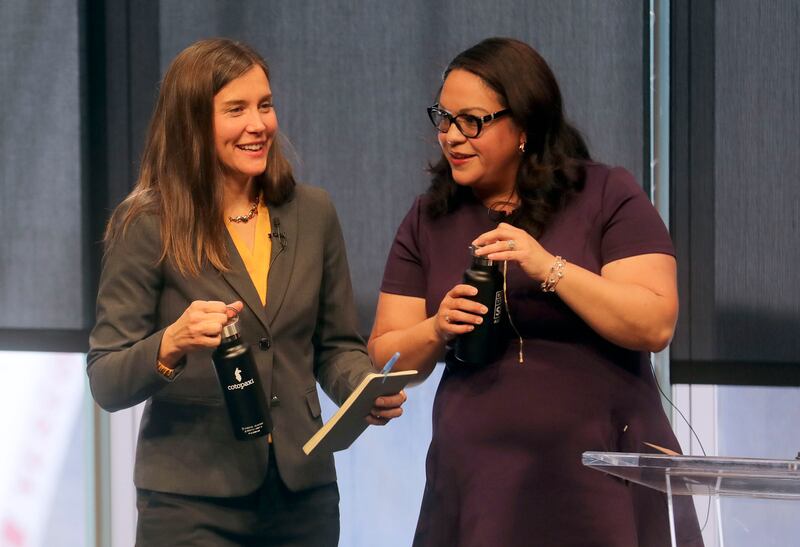Before you cast your vote in the Salt Lake City mayoral race on Nov. 5, read the Deseret News profiles of Luz Escamilla and Erin Mendenhall.
Luz Escamilla
State senator a ‘powerhouse’ symbolizing hope for minorities in her run for mayor
Campaign promises
Air quality
- Negotiate with Rocky Mountain Power to move the city’s transition to 100% renewable energy by 2023.
- Reduce tailpipe emissions by 25% by focusing on improving the transit system.
- Work with Utah Transit Authority to make mass transit options more affordable, convenient and accessible and upgrade buses and trains to run on 100% electricity.
- Push to make new construction net zero by requiring incentives to ensure builders move away from natural gas.
- Fast-track net zero construction by exploring an alternative permitting process, which may require working with the Utah Legislature.
- Introduce point-of-sale ordinances that require upgrades and offer financing programs to help homeowners make emission improvements to existing buildings.
Affordable Housing
- Dedicate significant and ongoing funding to the city’s Housing Trust Fund and Redevelopment Agency.
- Use existing and underutilized city-owned property to develop affordable housing.
- Create permanent supportive housing.
- Create a housing voucher program through partnerships with the state.
- Preserve existing affordable housing using the city’s Community Land Trust.
- Encourage a variety of affordable housing options accessible to a mix of incomes in all communities across the city.
- Implement residential building standards from the Enterprise Green Community national program.
- Align city zoning ordinances and approval processes to provide the right types of housing faster.
Homelessness
- Make new homeless resource centers “more robust,” increase the number of beds available, and develop “wraparound” services to help those who are shelter-resistant.
- Convene a coalition of public-private partnerships to extend resources and services and continue to find solutions that will have impact.
- Collect adequate and accurate data from shelters, resource centers and service providers to properly track progress.
Education
- Use city dollars to invest in prenatal and early childhood care and education, child care for city employees, and further education programs and parenting workshops.
- Advocate for Salt Lake City schools and partner with the school district to provide counselors, nurses and access to health care, bring child care and high-quality preschool education to west-side neighborhoods, enhance after-school programs, increase safety on school campuses, and mitigate factors contributing to the school-to-prison pipeline.
- Work with and recruit new businesses to Salt Lake City to foster greater volunteer efforts in schools and increase financial support.
- Use youth student government or councils to leverage collaboration between the school district, Salt Lake Education Association, the City Council, the mayor’s office, and Salt Lake City legislators to better advocate together on Capitol Hill.
For more, visit Escamilla’s website at luzformayor.com
Erin Mendenhall
Erin Mendenhall: A lifelong war with pollution pushed her to run for Salt Lake mayor
Campaign promises
Air quality
- Negotiate with Rocky Mountain Power to accelerate the city’s transition to 100% renewable energy faster, before the current 2030 goal.
- Work with Utah Transit Authority to expand city bus routes, transition the fleet to all-electric and expand Hive Pass access.
- Raise environmental standards for new construction the city invests in and incentivize solar panels and other green technology.
- Create a program to help city residents trade in their gas snowblowers and lawn mowers for electric ones.
- Incentivize green retrofits for the “dirtiest” buildings in the city.
- Plant 4,000 new trees on the city’s west side during her first term to offset carbon dioxide emissions while increasing quality of life in west-side neighborhoods.
Affordable housing
- Expand the city redevelopment agency’s public-private partnership programs to push developers to include more affordable housing in their projects.
- Use a low-interest city program and a preservation fund to help landlords and property owners preserve the city’s current stock of affordable housing and prevent displacement of current renters.
- Work with homebuilders to find solutions for developing housing that is “accessible, sustainable and affordable,” to expand access to federal subsidies, stretching current subsidy programs further and developing new incentives for developers who use solar and renewable technology.
- Review city zoning codes and easing building restrictions to allow more housing types — including consideration of inclusionary zoning to require a minimum amount of affordable housing in new multifamily units.
- Ensure, if Salt Lake City wins the 2030 Olympics bid, that the Olympic Village housing is converted to affordable housing after the Games.
Homelessness
- Work with residents, downtown business leaders and state and county leaders to create an “emergency plan” to help residents in the winter and when shelters are full, and create a seasonal, low-barrier emergency shelter.
- Increase funding for the downtown ambassador and park ranger programs to help connect more people with supportive services.
- Strengthen tenant rights ordinances to prevent no-fault evictions and encourage landlords to be fair to their tenants.
Streets
- Create a new strategic plan for city roads and infrastructure.
- Find new revenue streams to finance road improvements without adding to taxpayer burden.
- Use impact fees collected from developers before they expire.
- Use the city app to increase the city’s response times to fill in potholes and speed up street repairs.
View Comments
For more, visit Mendenhall’s website at erinmendenhall.com.


